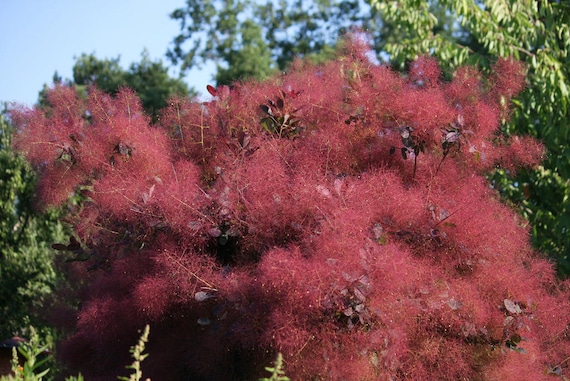Smoke tree and smoke bush are two terms that are often used interchangeably but there are some key differences between these two plants. While closely related, smoke trees form larger specimens with a tree-like habit while smoke bushes have a shrubby form. Let’s take a closer look at how to tell them apart.
What is a Smoke Tree?
Smoke trees belong to the genus Cotinus and are large, multi-trunked trees that can reach mature heights over 20 feet tall. There are two main species:
-
American smoke tree (Cotinus obovatus) – Native to the southeastern US
-
European smoke tree (Cotinus coggygria) – Native to southern Europe and Asia
Smoke trees are deciduous trees that are grown mainly for their airy, smoke-like flower panicles that emerge in early summer. The flowers are made up of fine hairs that give a fuzzy, whispy appearance.
Foliage on smoke trees is oval-shaped. It emerges reddish-purple in spring, turns green in summer, and develops vibrant orange, red, and purple tones in fall.
Popular smoke tree cultivars include:
-
‘Royal Purple’ – Deep reddish-purple leaves
-
‘Golden Spirit’ – Chartreuse yellow foliage
-
‘Grace’ – Hybrid with large lavender-pink panicles
Smoke trees thrive in full sun and well-drained soil. They are drought tolerant once established. With regular pruning, they can be maintained at a smaller size.
What is a Smoke Bush?
Smoke bushes are smaller, multi-stemmed shrubs in the Cotinus genus. They share the same smoke-like flower panicles and fall foliage as smoke trees. However, smoke bushes only grow 6-15 feet tall.
Smoke bushes are often coppiced, meaning they are cut back severely in late winter to promote bushy new growth. This keeps them maintained as a shrub versus becoming a tree.
Popular smoke bush cultivars include:
-
‘Royal Purple’ – Deep reddish-purple leaves
-
‘Velvet Cloak’ – Dark maroon foliage
-
‘Young Lady’ – Green leaves, compact habit
-
Winecraft Black® – Near-black leaves, compact to 10 feet
-
Winecraft Gold® – Bright chartreuse foliage, compact size
Smoke bushes work well in flower borders, hedges, and foundation plantings where a shorter shrub is desired. They share the same growing requirements as smoke trees.
Key Differences Between Smoke Trees and Smoke Bushes
While smoke trees and smoke bushes look similar, there are some key differences:
-
Height – Smoke trees reach over 20 feet, smoke bushes max out around 15 feet.
-
Form – Smoke trees have an upright, tree-like shape. Smoke bushes are multi-stemmed shrubs.
-
Leaves – Smoke tree leaves are a bit larger and more rounded. Smoke bushes have smaller, more elliptic leaves.
-
Flowers – Smoke tree flower panicles can be slightly larger, but otherwise very similar.
-
Uses – Smoke bushes used more often in shrub borders, smoke trees used as specimen trees.
Tips for Growing Smoke Trees and Smoke Bushes
Follow these tips for successfully growing smoke trees and smoke bushes:
-
Choose an appropriate size for your needs – tree form or shrub form.
-
Plant in full sun in well-drained, even poor quality soil. Avoid wet, heavy clay soil.
-
Prune smoke bushes yearly to maintain shrub form. Prune smoke trees only as needed.
-
Water regularly until established, then taper off except in droughts.
-
Apply mulch around the base to retain moisture and reduce weeds.
-
Coppice smoke bushes every few years to rejuvenate growth.
-
Watch for leaf spot, rust, and verticillium wilt disease. Improve air circulation with pruning.
Adding Wispy Elegance to Your Landscape
With their elegant, smoky blooms and fantastic foliage, it’s easy to see why smoke bushes and smoke trees are treasured landscape plants. Pay attention to their mature size and form to choose the right one for your needs. Then sit back and enjoy the graceful, wispy blooms they provide year after year.
All About Royal Purple Smoke Tree
FAQ
Can you make a smoke bush into a tree?
What are the cons of Royal purple smoke tree?
How to identify a smoke tree?
Do smoke bushes like sun or shade?

